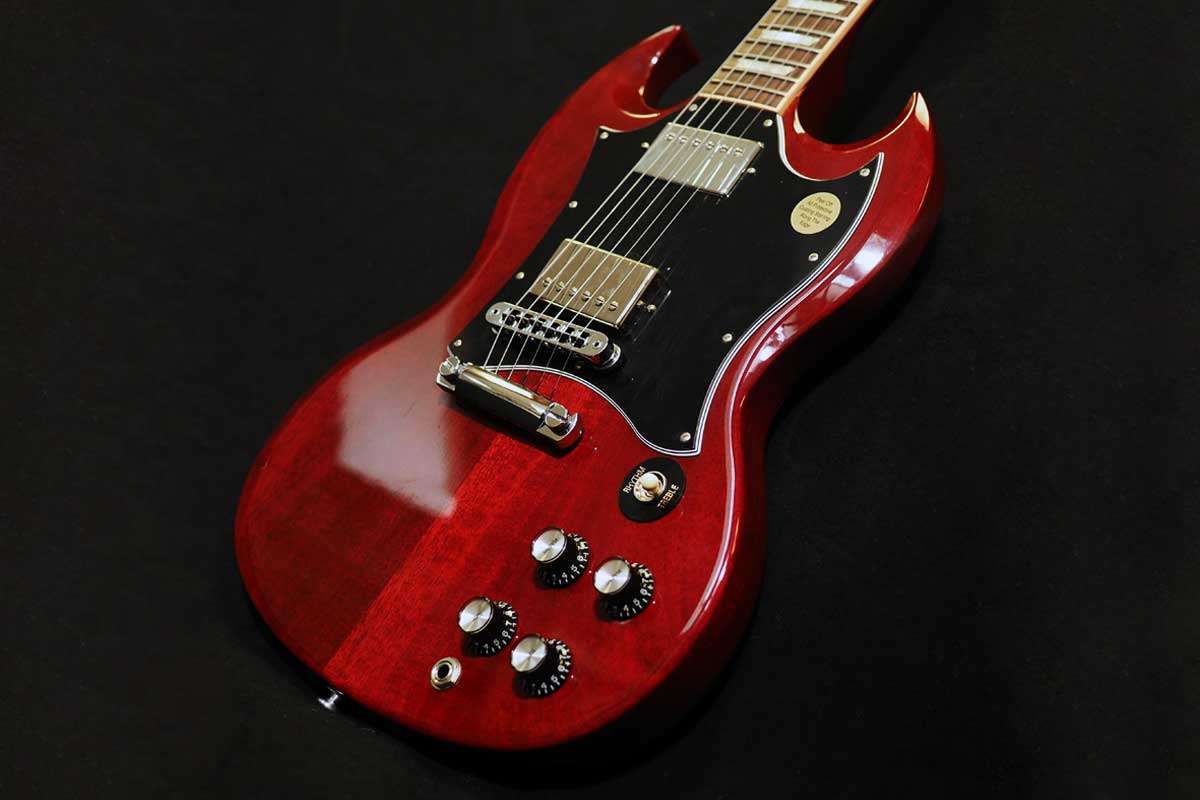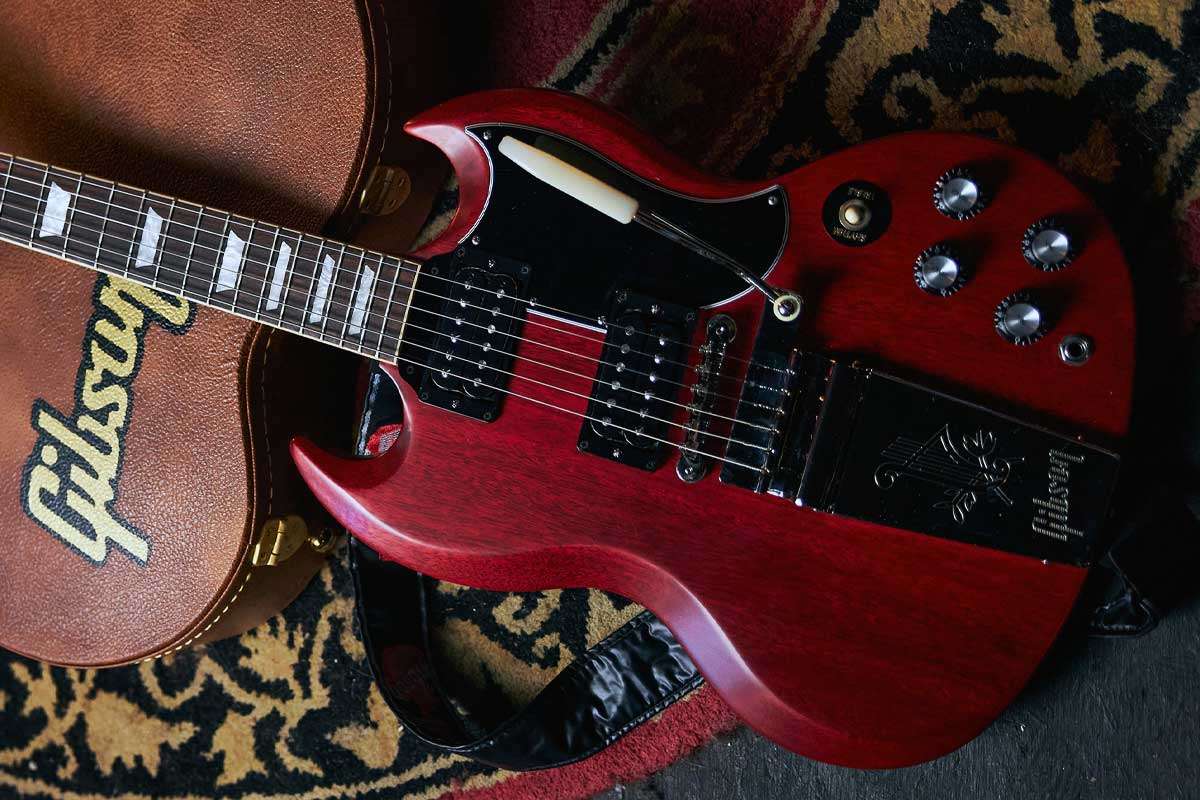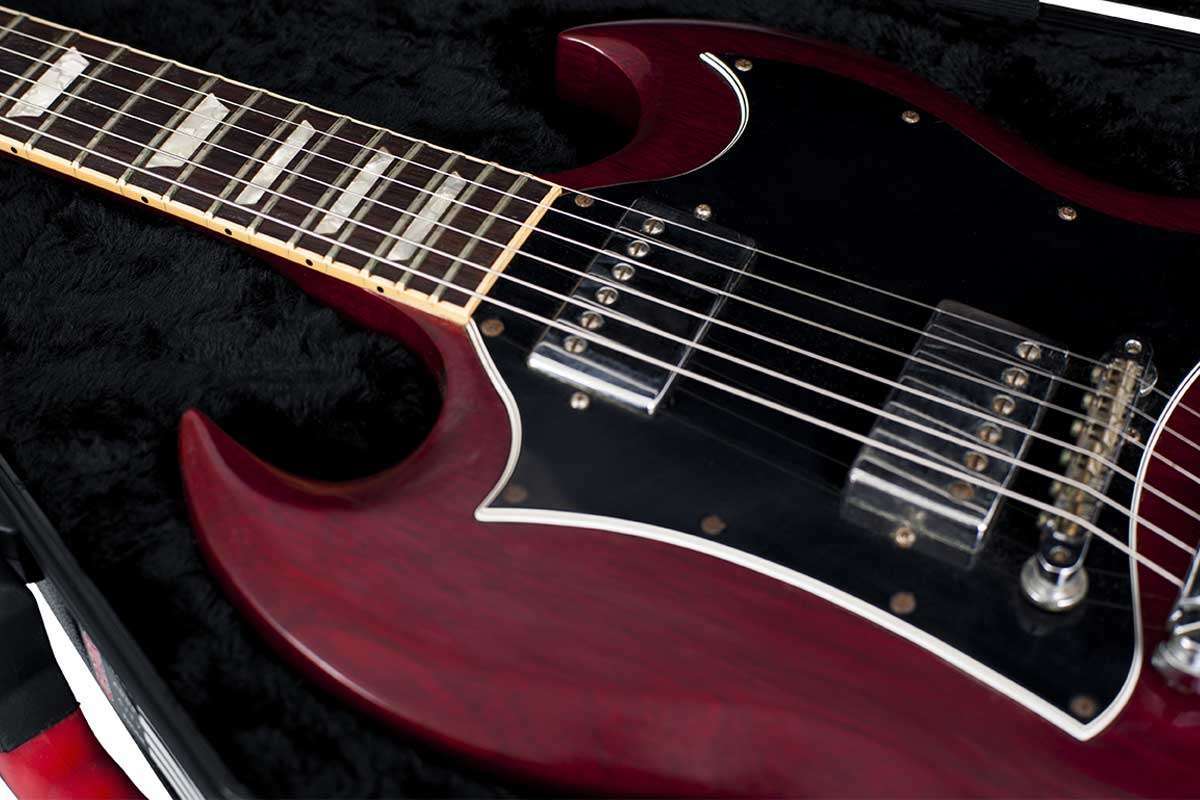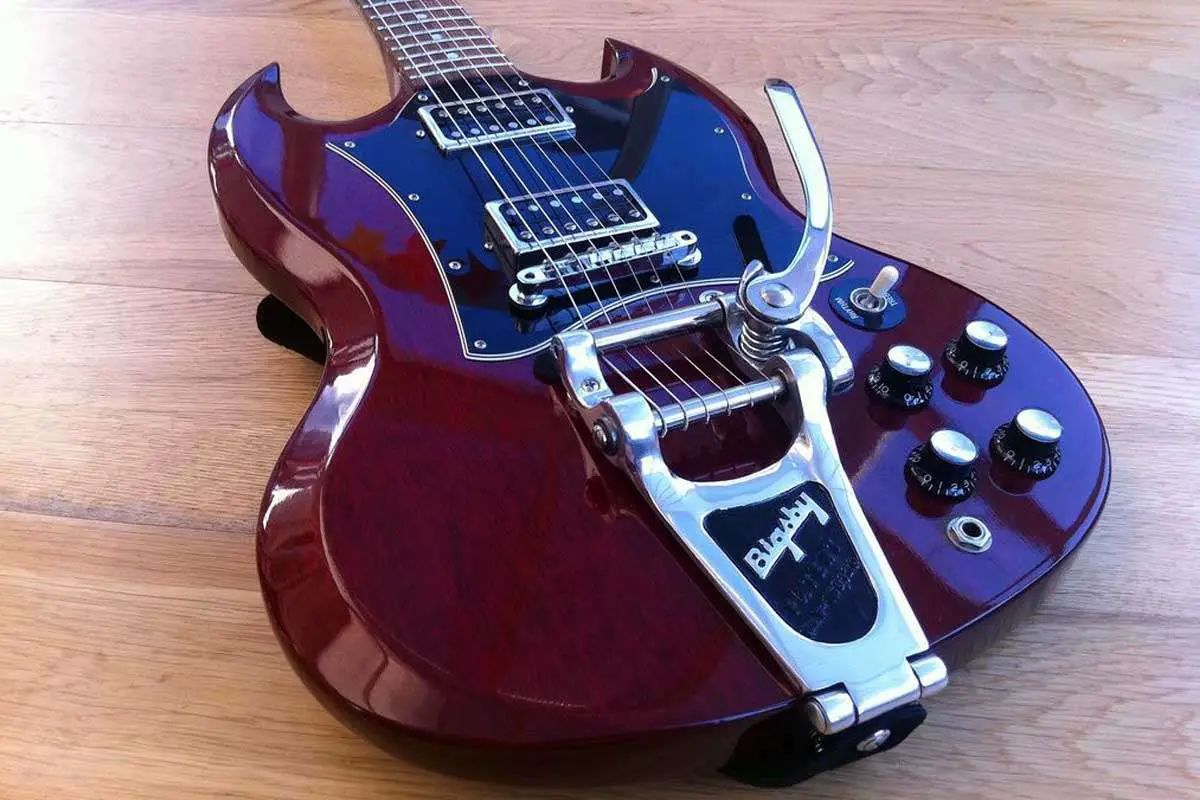If you’re a guitar enthusiast, chances are you’re familiar with the Gibson SG. This legendary guitar has graced the music world for more than sixty years and has been wielded by some of the most iconic guitarists in history, including Angus Young, Tony Iommi, and Eric Clapton. But have you ever pondered the question: “What does SG stand for in Gibson?” In this article, we’ll delve into the roots of this name and decipher its significance in the realm of guitars.
The Gibson SG was first introduced in 1961 as a successor to the Les Paul model. The Les Paul had been Gibson’s flagship guitar for almost a decade, but the company was looking to update the design to stay competitive with other guitar manufacturers. The SG was a radical departure from the Les Paul, with a thinner, lighter body and a sleek, modern look. But what does SG stand for?
The answer is simple: Solid Guitar. The SG was designed to be a solid-body electric guitar, as opposed to a hollow-body or semi-hollow guitar like the ES-335.

Understanding the Gibson SG
If you are a guitar enthusiast, you have probably heard of the Gibson SG. The SG is a popular electric guitar model that has been around since the 1960s. But what does SG stand for in Gibson SG? In this section, we will explore the origins of the SG design and what makes it unique.
The SG stands for “solid guitar” and was introduced by Gibson in 1961 as a redesign of the Les Paul model. The SG design features a thinner, more contoured body than the Les Paul, with a double cutaway that makes the upper frets more accessible. This design change was further eased by moving the neck joint outwards by three frets, making it easier to play higher notes.
The Gibson SG quickly became popular among guitarists, thanks to its sleek design and powerful sound. The SG design features a solid mahogany body and neck, with a rosewood fingerboard. The guitar is equipped with two humbucking pickups, which provide a warm, full-bodied tone that is perfect for rock and blues music.
One of the unique features of the SG design is the placement of the pickups. Unlike other electric guitar models, the SG has the pickups closer to the bridge, which gives it a brighter, more focused sound. The SG also features a tune-o-matic bridge, which allows for precise intonation and easy adjustments.
In conclusion, the Gibson SG is a popular electric guitar model that has been around since the 1960s. The SG design features a thinner, more contoured body than the Les Paul, with a double cutaway that makes the upper frets more accessible. The SG is equipped with two humbucking pickups and features a tune-o-matic bridge, which allows for precise intonation and easy adjustments. The SG design is unique and has become a favorite among guitarists for its sleek design and powerful sound.
Historical Context of the Gibson SG
The Gibson SG was first introduced in 1961 as a successor to the Les Paul model. It quickly became one of the most iconic guitars in rock history, with its distinctive double cutaway design and devil-horned shape.
The origins of the SG can be traced back to the early 1950s, when Gibson introduced the Les Paul model. Les Paul himself was a popular musician and inventor who had been experimenting with solid-body electric guitars since the 1940s. He teamed up with Gibson to create a guitar that would be both versatile and visually appealing.
However, by the late 1950s, the Les Paul model was losing popularity. Fender’s Stratocaster was becoming the guitar of choice for many musicians, and Gibson needed to come up with a new design that would compete. This led to the development of the SG.
The SG was designed by Gibson’s Ted McCarty, with input from Les Paul himself. However, Les Paul was not entirely happy with the new design, and he eventually severed his ties with Gibson in 1962. This was partly due to personal issues, including his divorce from his wife Mary Ford, but also because of a contract dispute.
Despite this setback, the SG continued to gain popularity throughout the 1960s, thanks in part to its use by influential musicians such as Sister Rosetta Tharpe and George Harrison. It remains one of Gibson’s most popular models to this day.
Related: The history of the electric guitar

Different Variants of Gibson SG
Gibson SG has been around for over six decades, and during this time, the company has produced several variants of the guitar. Each variant has its unique features, and some are more popular than others. In this section, we will take a look at some of the most popular variants of the Gibson SG.
SG Standard
The SG Standard is the base model of the Gibson SG. It has a slim taper neck profile that provides a comfortable playing experience. The guitar features a mahogany body and neck, a rosewood fretboard, and two humbucker pickups. The SG Standard is available in a variety of finishes, including Ebony, Heritage Cherry, and Vintage Burst.
SG Special
The SG Special is a stripped-down version of the SG Standard. It features a mahogany body and neck, a rosewood fretboard, and one or two P-90 pickups. The guitar has a wraparound bridge, which makes it easier to change strings. The SG Special is available in a variety of finishes, including Faded Pelham Blue, Sparkling Burgundy, and Vintage Sparkling Burgundy.
SG Custom
The SG Custom is a high-end variant of the Gibson SG. It features a mahogany body and neck, a bound ebony fretboard, and three humbucker pickups. The guitar has a gold-plated hardware, including the tune-o-matic bridge and stop bar tailpiece. The SG Custom is available in a variety of finishes, including Alpine White, Ebony, and Heritage Cherry.
SG Junior
The SG Junior is a single-pickup variant of the Gibson SG. It features a mahogany body and neck, a rosewood fretboard, and a single P-90 pickup. The guitar has a wraparound bridge, which makes it easier to change strings. The SG Junior is available in a variety of finishes, including Faded Cherry and Vintage Sunburst.
SG Pro
The SG Pro is a variant of the Gibson SG that was produced in the late 1960s. It features a mahogany body and neck, a rosewood fretboard, and two humbucker pickups. The guitar has a vibrola tailpiece, which allows players to bend notes. The SG Pro is available in a variety of finishes, including Cherry and Walnut.
SG Classic
The SG Classic is a variant of the Gibson SG that was produced in the early 2000s. It features a mahogany body and neck, a rosewood fretboard, and two P-90 pickups. The guitar has a wraparound bridge, which makes it easier to change strings. The SG Classic is available in a variety of finishes, including Pelham Blue and Heritage Cherry.
Les Paul Custom
The Les Paul Custom is a high-end variant of the Gibson Les Paul. It features a mahogany body and neck, a bound ebony fretboard, and two humbucker pickups. The guitar has a gold-plated hardware, including the tune-o-matic bridge and stop bar tailpiece. The Les Paul Custom is available in a variety of finishes, including Alpine White and Ebony.
Les Paul Junior
The Les Paul Junior is a single-pickup variant of the Gibson Les Paul. It features a mahogany body and neck, a rosewood fretboard, and a single P-90 pickup. The guitar has a wraparound bridge, which makes it easier to change strings. The Les Paul Junior is available in a variety of finishes, including Vintage Sunburst and Cherry.
Les Paul Standard
The Les Paul Standard is the base model of the Gibson Les Paul. It features a mahogany body and neck, a rosewood fretboard, and two humbucker pickups. The guitar has a tune-o-matic bridge and stop bar tailpiece. The Les Paul Standard is available in a variety of finishes, including Heritage Cherry, Honeyburst, and Tobacco Burst.
In conclusion, the Gibson SG has been around for over six decades, and during this time, the company has produced several variants of the guitar. Each variant has its unique features, and some are more popular than others. Whether you are a beginner or a professional, there is a Gibson SG variant that will suit your needs.
Related: The anatomy of an electric guitar

Design and Construction of Gibson SG
If you’re wondering what SG stands for in Gibson SG, it stands for “solid guitar.” The Gibson SG is a solid-body electric guitar model that was introduced by Gibson in 1961. It was designed as a replacement for the original Les Paul model, and it has since become one of the most popular guitar models of all time.
The design of the Gibson SG is a radical departure from the Les Paul model, with a more modern and sculpted look. The body of the SG is made from mahogany, and it features bevels and angles that give it a unique and distinctive appearance. The double cutaway design allows for easy access to the upper frets, and the horns of the guitar are elongated and pointed.
The neck of the Gibson SG is made from mahogany and is set into the body of the guitar. The neck is available in different profiles, including slim taper, rounded, and asymmetrical. The headstock of the SG is also unique, with a pointed design that complements the rest of the guitar.
The finish of the Gibson SG is typically cherry, although other finishes are available. The cherry finish is achieved through a process of staining and sealing the mahogany body of the guitar. The finish is then polished to a high gloss, giving the guitar a rich and vibrant appearance.
There are many variations of the Gibson SG available, including the SG Standard, SG Special, and SG Custom. Each of these models has its own unique features and specifications, such as different pickups, finishes, and hardware.
In summary, the Gibson SG is a solid-body electric guitar model that is known for its distinctive design and construction. The guitar features a mahogany body with bevels and angles, a double cutaway design, and a unique headstock. The neck is also made from mahogany and is available in different profiles. The finish of the guitar is typically cherry, although other finishes are available, and there are many variations of the SG available to suit different playing styles and preferences.
Key Features of Gibson SG
The Gibson SG is a solid-body electric guitar that has been a staple in rock music for decades. It has a distinctive double-cutaway design and is known for its bright tone and powerful sound. Here are some of the key features that make the Gibson SG stand out:
Body and Neck Joint
The Gibson SG has a solid mahogany body that is lightweight and comfortable to play. The neck joint is a set-in design, which means that the neck is glued into the body. This provides a strong and stable connection between the neck and body, which helps to improve sustain and tone.
Fingerboard and Inlays
The fingerboard of the Gibson SG is made from rosewood or ebony, which provides a smooth and comfortable playing surface. The inlays on the fingerboard are typically either dot or trapezoid shapes, depending on the model.
Pickups and Controls
The Gibson SG is known for its powerful and versatile pickups. Most models feature two humbucking pickups, which provide a thick and rich tone. The pickups are controlled by a volume and tone knob for each pickup, as well as a three-way pickup selector switch.
Bridge and Tailpiece
The Gibson SG typically features a tune-o-matic bridge and a stopbar tailpiece. This combination provides excellent intonation and sustain, as well as easy string changes.
Weight and Balance
One of the key features of the Gibson SG is its lightweight design. This makes it easy to play for long periods of time without experiencing fatigue. The balance of the guitar is also excellent, which helps to improve playability and comfort.
Vibrato
Some models of the Gibson SG feature a vibrato tailpiece, which allows you to add vibrato and other effects to your playing. This can be a great way to add expression and emotion to your playing, and can be especially useful for lead guitarists.
Overall, the Gibson SG is a powerful and versatile guitar that is perfect for rock and other styles of music. It has a distinctive look and sound that make it a favorite of many guitarists around the world.
Comparisons and Contrasts
If you’re trying to decide between an SG and another type of guitar, it’s helpful to know the differences and similarities. Here’s a breakdown of how the SG stacks up against some other popular models:
Les Paul
The Les Paul is a classic Gibson model, and it’s often compared to the SG. Here are some of the main differences:
- The Les Paul has a thicker body than the SG, which gives it a warmer, more sustain-heavy sound.
- Les Pauls typically have a set neck, while SGs have a bolt-on neck. This can affect the overall feel and playability of the guitar.
- Les Pauls usually have a tune-o-matic bridge and stopbar tailpiece, while SGs have a wraparound bridge or a tune-o-matic with a tremolo tailpiece.
Fender Stratocaster
The Stratocaster is a solid-body electric guitar made by Fender. Here are some key differences between the SG and the Strat:
- The Stratocaster has a double cutaway body, like the SG, which makes it easy to access the upper frets. However, the Strat has a more contoured body shape than the SG.
- Stratocasters usually have three single-coil pickups, while SGs typically have two humbuckers or P90s. This affects the overall sound of the guitar.
- The Stratocaster has a tremolo arm, which allows you to create vibrato effects. SGs sometimes have a tremolo tailpiece, but not always.
Related: Famous Stratocaster Players
ES-335
The ES-335 is a semi-hollow body electric guitar made by Gibson. Here are some differences between the SG and the ES-335:
- The ES-335 has a semi-hollow body, which gives it a more resonant, acoustic-like sound than the SG.
- The ES-335 typically has a set neck, while SGs have a bolt-on neck.
- ES-335s usually have a tune-o-matic bridge and stopbar tailpiece, while SGs have a wraparound bridge or a tune-o-matic with a tremolo tailpiece.
Epiphone
Epiphone is a brand that makes guitars similar to Gibson models, but at a lower price point. Here are some differences between the SG and the Epiphone equivalent:
- Epiphone SGs usually have a bolt-on neck, while Gibson SGs have a set neck.
- Epiphone SGs often have a black pickguard, while Gibson SGs usually have a white pickguard.
- Epiphone SGs may have slightly different hardware and electronics than Gibson SGs, which can affect the overall sound and playability of the guitar.
Overall, the SG is a unique guitar with its own distinct sound and style. While it shares some similarities with other popular models, it has its own character and personality that sets it apart.

Iconic Gibson SG Users
When it comes to iconic Gibson SG users, there are many names that come to mind. From Eric Clapton, Pete Townshend, Jimmy Page, and Angus Young to Tony Iommi, the Gibson SG has been a favorite of some of the biggest names in rock history.
Eric Clapton, for instance, is known for his use of the Gibson SG during his time with Cream in the late 1960s. The band’s hit song “Sunshine of Your Love” features Clapton’s signature SG sound, which is characterized by its bright, biting tone and sustain.
Another legendary guitarist who has made the Gibson SG his own is Pete Townshend of The Who. Townshend’s use of the SG can be heard on classic tracks like “I Can’t Explain” and “My Generation,” where his aggressive playing style is perfectly complemented by the guitar’s sharp, biting tone.
Jimmy Page of Led Zeppelin is another iconic SG user, and his use of the guitar can be heard on some of the band’s biggest hits, including “Whole Lotta Love” and “Black Dog.” Page’s SG is known for its warm, rich tone and its ability to cut through the mix, making it the perfect guitar for his heavy, riff-based playing style.
Angus Young of AC/DC is perhaps the most famous SG player of all time, and his use of the guitar has helped define the band’s signature sound. Young’s SG is known for its bright, biting tone and its ability to deliver powerful, driving riffs that are instantly recognizable.
Tony Iommi of Black Sabbath is another iconic SG player, and his use of the guitar has helped define the sound of heavy metal. Iommi’s SG is known for its thick, heavy tone and its ability to deliver crushing riffs that are both dark and menacing.
Finally, Derek Trucks is a modern-day SG player who has made a name for himself with his virtuosic slide guitar playing. Trucks’ SG is known for its warm, rich tone and its ability to deliver soulful, expressive solos that are both melodic and emotional.
In conclusion, the Gibson SG has been a favorite of some of the biggest names in rock history, from Eric Clapton and Pete Townshend to Jimmy Page, Angus Young, Tony Iommi, and Derek Trucks. Whether you’re looking for a bright, biting tone or a warm, rich sound, the Gibson SG is a versatile guitar that can deliver it all.

Special Editions and Customizations
If you’re looking for a unique SG guitar, you might want to consider one of Gibson’s special editions or customizations. These guitars feature special finishes, hardware, and pickups that set them apart from standard SG models.
One popular special edition is the SG TV. This guitar features a distinctive “limed mahogany” finish and a single P-90 pickup, giving it a vintage look and sound. The SG Goldtop is another classic special edition, with a gold finish and two P-90 pickups.
If you’re looking for a more modern take on the SG, you might be interested in a Bigsby-equipped model. The Bigsby vibrato tailpiece adds a unique touch to the SG’s already versatile sound. The SG Custom Shop is another option for those looking for a truly custom guitar. These guitars are built to order and can feature a wide range of customizations, from unique finishes to custom pickups and hardware.
For those who prefer gold hardware, the SG Standard Gold Hardware model is a great choice. This guitar features gold hardware and two humbucking pickups for a rich, full sound. The SG Les Paul Special is another popular option, with a unique double-cutaway design and two P-90 pickups.
If you’re looking to shred some solos, you might be interested in a prototype SG model. These guitars are designed for maximum playability and often feature slim necks and high-output pickups. Whether you’re a beginner or a seasoned pro, there’s an SG special edition or customization that’s perfect for you.
Pricing and Market Value
When it comes to pricing and market value, the Gibson SG Standard is a popular and well-regarded guitar model that has been produced in many variations since its introduction in 1961. As of August 2023, the core model of the SG Standard is currently retailing at $1,799.00 in most markets, according to a price guide from Guitar Chalk. This price may vary depending on the specific model and any additional features or modifications.
If you’re looking to purchase a used SG Standard, you may be able to find one at a steep discount, up to 40 percent off in some cases, according to Guitar Chalk. However, it’s important to be cautious when buying used instruments, as they may have hidden defects or damage that can affect their value and playability.
In addition to the SG Standard, there are also other SG models available from Gibson and Epiphone at varying price points. For example, Epiphone offers a range of value-priced SG models that are designed to provide a similar look and feel to the Gibson originals at a more affordable price point, according to a buying guide from Musician’s Friend. Gibson also offers a range of SG models, including custom shop and USA models, which may have higher price points due to their premium features and construction.
When it comes to market value, vintage SG models from the 1960s can be highly sought after and valuable to collectors and players alike. According to Garrett Park Guitars, a vintage guitar authority, 1960s Gibson SGs can range in value from $3,000 to $17,000 depending on a variety of factors. These factors may include the guitar’s condition, rarity, historical significance, and provenance.
Overall, the pricing and market value of Gibson SG guitars can vary widely depending on a range of factors, including the specific model, features, condition, and historical significance. If you’re looking to purchase an SG guitar, it’s important to do your research and consider all of these factors carefully to ensure that you’re getting the best value for your budget and needs.
Conclusion
In conclusion, the SG in Gibson SG stands for “solid guitar.” The Gibson SG was introduced in 1961 and has since become a popular model among guitarists. It features a thinner, more contoured body than the Les Paul and a double cutaway.
The SG has undergone many variations over the years, including the SG Special and SG Standard. The SG Special is equipped with an Ivory Tusq nut, which provides clear tones while playing open strings. On the other hand, the SG Standard features humbucker pickups that give it better tonal dynamics than the SG Special.
Les Paul played a significant role in the development of the Gibson SG, and his contract with Gibson ensured that he would receive royalties for every instrument made by Gibson that had a pickup on it. This contract helped to establish Gibson as a leading manufacturer of electric guitars.
Overall, the Gibson SG is a solid guitar that has stood the test of time. Its unique design and sound have made it a favorite among guitarists for over 60 years. Whether you’re a beginner or a seasoned pro, the Gibson SG is a great choice for anyone looking for a high-quality electric guitar.
Related: Why Music Theory Is Important
